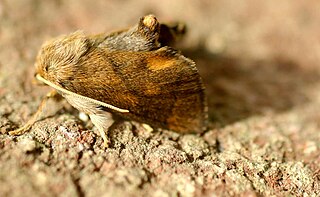
The Drepanidae are a family of moths with about 660 species described worldwide. They are generally divided in three subfamilies, which share the same type of hearing organ. Thyatirinae, previously often placed in their own family, bear a superficial resemblance to Noctuidae. Many species in the drepanid family have a distinctively hook-shaped apex to the fore wing, leading to their common name of hook-tips.

The Limacodidae or Eucleidae are a family of moths in the superfamily Zygaenoidea or the Cossoidea; the placement is in dispute. They are often called slug moths because their caterpillars bear a distinct resemblance to slugs. They are also called cup moths because of the shape of their cocoons.

Callidulidae, the only known family of the superfamily Calliduloidea, is the family of Old World butterfly-moths, containing eight genera. They have a peculiar distribution, restricted to the Old World tropics of Southeast Asia to Australasia and Madagascar. The three subfamilies exhibit both day- and night-flying behaviour.
Pomasia is a genus of moths in the family Geometridae.

Asthenini is a tribe of geometer moths under subfamily Larentiinae first described by Warren in 1893. The tribe has been combined with Eupitheciini in the past, most notably by Jeremy Daniel Holloway in his work The Moths of Borneo.

Eupitheciini is a tribe of geometer moths under subfamily Larentiinae, often referred to as pugs. The tribe was described by Tutt in 1896.
The Catephiini are a tribe of moths in the family Erebidae.
Pomasia vernacularia is a moth in the family Geometridae. It is found on Borneo.
Pomasia sacculobata is a moth in the family Geometridae. It is found on Peninsular Malaysia and Borneo.
Pomasia reticulata is a moth in the family Geometridae first described by George Hampson in 1895. It is found in the Mergui Archipelago of Myanmar and in Penang in Peninsular Malaysia and in Borneo. The habitat primarily consists of coastal areas.
Pomasia galastis is a moth in the family Geometridae. It is found in the north-eastern Himalayas and on Borneo. The habitat consists of forests, including secondary forests, from lowland areas to altitudes of about 1,700 meters.
Pomasia lamunin is a moth in the family Geometridae. It is found on Borneo. The species is found from lowland areas to the lower montane zone.
Pomasia lacunaria is a moth in the family Geometridae. It is found on Borneo and Peninsular Malaysia. The habitat consists of lowland forests.
Pomasia luteata is a moth in the family Geometridae. It is found on Borneo and Peninsular Malaysia. The species is found from lowland areas to the upper montane zone.
Pomasia nuriae is a moth in the family Geometridae. It is found on Borneo and possibly Peninsular Malaysia. The habitat consists of lowland areas.
Pomasia obliterata is a moth in the family Geometridae. It is found on Borneo, Peninsular Malaysia and Siberut Island. The habitat consists of lowland areas, including alluvial forests.
Pomasia denticlathrata is a moth in the family Geometridae first described by William Warren in 1893. It is found in India, Japan and Taiwan.
Pomasia parerga is a moth in the family Geometridae. It is found in north-eastern India.
Pomasia psylaria is a moth in the family Geometridae. It is found in Sri Lanka.
Pomasia punctaria is a moth in the family Geometridae. It is found in India.




